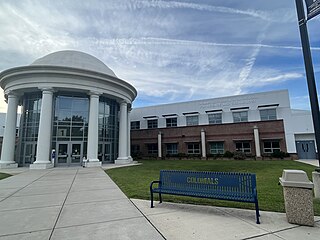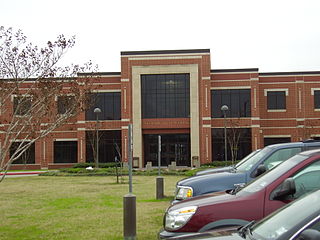
In the U.S. education system, magnet schools are public schools with specialized courses or curricula. Normally, a student will attend an elementary school, and this also determines the middle school and high school they attend unless they move. "Magnet" refers to how magnet schools accept students from different areas, pulling students out of the normal progression of schools. Attending them is voluntary.

Seward is a neighborhood in the Longfellow community of Minneapolis, Minnesota, located geographically southeast of downtown. It consists of the land bordered by the Hiawatha Avenue industrial district to the west, Minneapolis Midtown Greenway to the south, the Mississippi River to the east, and Interstate 94 to the north.
Richfield Public Schools, officially Independent School District #280, is the school district for Richfield, and a portion of neighboring Edina, Minnesota.

The Des Moines Independent Community School District is the largest public school district in Iowa. It is accredited by the North Central Association of Secondary Schools and Colleges and the Iowa Department of Education.

Westside High School is a secondary school in Houston, Texas, United States. It serves grades 9 through 12 and is part of the Houston Independent School District.

Milwaukee Public Schools (MPS) is the largest school district in Wisconsin. As of the 2015–16 school year, MPS served 75,568 students in 154 schools and had 9,636 full-time equivalent (FTE) staff positions. The system is one of the largest in the United States by enrollment. A publicly elected school board, the Milwaukee Board of School Directors, provides direction and oversight, with a superintendent heading the organization's administration.

Prince George's County Public Schools (PGCPS) is a public school district that serves Prince George's County, Maryland. During the 2023-2024 academic year, the district enrolls around 133,000 students and operates over 200 schools. PGCPS is the second-largest school district in Maryland, the third-largest district in the Washington-Baltimore metropolitan area, the 18th-largest in the United States, and the nation's largest school district with a majority-black student population.

The Richmond County School System is an American public school system based in Augusta, Georgia. It is run by the Richmond County Board of Education which, under Article VIII, § V, Paragraph 2, requires that each school system be under the management and control of an elected board of education. As elected Constitutional officials of Georgia, the school board members are responsible for setting educational policies, employing school personnel, providing buildings and equipment, operating a transportation system, and disbursing school funds. The board of education meets in the Richmond County Board of Education building at 864 Broad Street in Augusta, Georgia. It serves consolidated Augusta-Richmond County, Georgia and the south Richmond County cities of Hephzibah and Blythe. The system has an enrollment of around 32,000 students, attending 36 elementary schools, ten middle schools, eight high schools, four magnet schools, and three other schools. The school board has its own police department which provides law enforcement services to all the district's schools.

Orange County Public Schools (OCPS) is the public school district for Orange County, Florida. It is based in the Ronald Blocker Educational Leadership Center in downtown Orlando. OCPS is the eighth-largest school district in the United States and the fourth-largest in Florida. The district serves about 209,000 students at 210 schools and is one of the largest employers in Central Florida with more than 25,000 team members.
There are an assortment of public, private, and parochial schools in Norwalk, Connecticut.

Bryn Mawr is a neighborhood within the Calhoun-Isles community in Minneapolis located directly west of downtown Minneapolis. It is in Ward 7, represented by council member Katie Cashman.
Saint Paul, Minnesota contains many educational institutions from grade school to high school, college and beyond. A number of educational "firsts" have happened in Saint Paul. Hamline University, the first and oldest college in Minnesota, was founded in Saint Paul in 1854. In 1991, Minnesota became the first state in the United States to pass legislation allowing the existence of charter schools. The following year, the first charter school in the nation, City Academy High School, was established in Saint Paul. The oldest library in Minnesota, the Minnesota State Law Library, was opened in 1849.
Eugene School District (4J) is a public school district in the U.S. state of Oregon. It is one of two school districts that serve the city of Eugene.

Saint Paul Public Schools (SPPS) is a school district (ISD #625) that operates in Saint Paul, Minnesota.
Polk County Public Schools is a school district headquartered in Bartow, Florida, United States. The district serves Polk County.
Racine Unified School District (RUSD) is a school district serving the eastern portion of Racine County, Wisconsin. It encompasses a 100 sq mi (260 km2) area, and serves the city of Racine and six other towns and villages, which had a combined population of 139,193 at the 2010 census. RUSD is the fifth-largest school district in Wisconsin. It has 31 schools, with a student enrollment of 19,455. The district employs 1,757 teachers and 171 administrators.

Wichita USD 259 is a public unified school district headquartered in Wichita, Kansas, United States. The district includes most of the cities of Wichita, Bel Aire, Eastborough, and Kechi.

Ella J. Baker Montessori School, formerly Woodrow Wilson Montessori School and Woodrow Wilson Elementary School, is a public K-8 Montessori school in the Cherryhurst Addition subdivision in the Neartown area of Houston, Texas. A part of the Houston Independent School District (HISD), Baker serves as the neighborhood elementary school for a section of Neartown, including a portion of Montrose. It also serves as a magnet school for all of HISD's territory. As of 2014 it is one of three public Montessori programs in Houston. It was the first HISD school to use the Montessori style for all students, as well as housing HISD's first Montessori middle school program.














